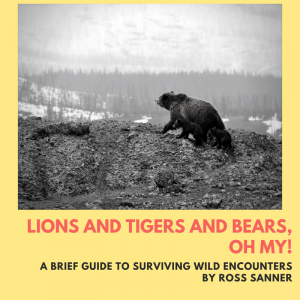If you spend time on the trail, chances are that you’ll encounter some manner of wildlife along the way. This is part of the fun of hiking and camping, and getting a good look at an animal can be rewarding after hours in the woods. However, always respect nature during your travels; even with harmless animals, keep a respectable distance and leave their environment as you found it. However, you may happen upon something a little more threatening than the average tree squirrel, and knowing the proper behavior can keep you or the animal from being injured.
Deer
While they may seem docile and timid, bucks in heat can be aggressive toward travelers. Additionally, deer-related car accidents cause dozens of deaths every year. However, we’re going to focus on what you should do when coming across a territorial deer.
While bucks are most dangerous when mating in fall and winter, you should avoid approaching any deer at any time of year; does protecting their fawns can also be dangerous. While deer can be threatening, the most important thing to remember is that they will likely not chase you if you stay out of their way. Don’t turn your back on a deer and wave anything that you may have on you to make yourself appear larger. Loud noises can also help scare them off.
Big Cats
While they are increasingly uncommon in the United States, mountain lions can still be a force to be reckoned with if encountered by a traveler. That said, they generally won’t go after humans; if you keep yourself as obvious as possible and stand tall, there’s a good chance that they won’t give you a second look.
That said, if one approaches you, stand your ground; fleeing will make it want to chase you. Again, making a commotion and making yourself look larger can scare the cat off, but the important thing is to continue resisting even if it attacks you. Big cats will generally leave prey alone if they deem it to be too much trouble to subdue.
Rattlesnakes
Despite their fearsome appearance, rattlesnakes are at least kind enough to give you an auditory warning that they’ve been disturbed. Like the other animals on this list, they’ll generally leave you alone unless you give them reason to attack.
However, if you accidentally step on or too close to them, you may find yourself on the wrong end of their fangs. To avoid this, wear boots and long pants, and stay on trails, avoiding heavy underbrush. Rattlesnakes also spend much of their time in crevices, wood piles, or small areas that could provide shelter for an errant snake, so watch your hands when climbing or retrieving firewood.
Bears
Oh yes, the stereotypical bane of campers: the bear. While responsible for very few deaths per year, they have still gained a reputation as fearsome animals, and for good reason; their size and massive claws make them intimidating.
However, it’s important to know the difference between grizzly and black bears. Generally, the differences are obvious; grizzlies are brown, larger, and possess massive claws, whereas black bears are colored differently, smaller, and much more common. That said, while black bears rarely attack and can generally be scared off by making a lot of noise or fighting back in a pinch, keep in mind that they are still highly dangerous predators, especially if you should have the misfortune of coming between a mother bear and her cubs.
Grizzly bears, on the other hand, are not easily swayed and impossible to outrun. Carrying bear spray can often stop a grizzly in its tracks, but if you are attacked by one of these bears, playing dead is your best solution. Cover the back of your neck and lie in the fetal position until you’re absolutely sure that the bear has left the area; it is less likely to see you as a threat this way.

